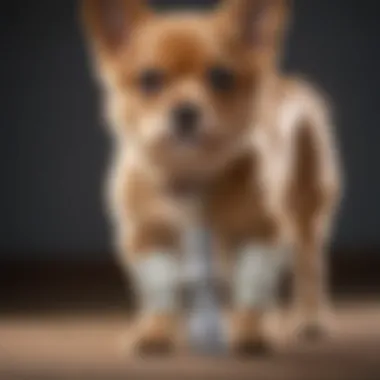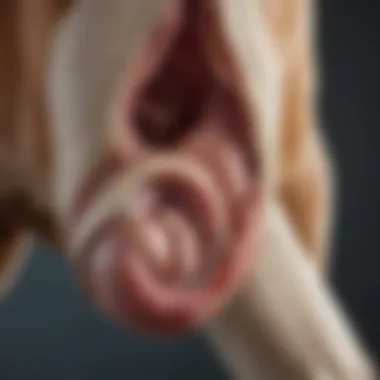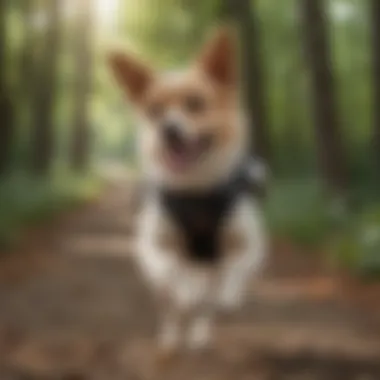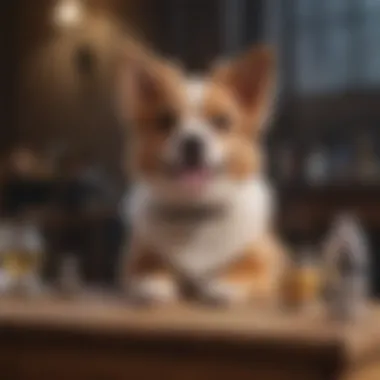Understanding Hock Braces for Small Dogs: Essential Guide


Intro
The hock joint plays a crucial role in the movement and stability of small dogs. Understanding its anatomy and function is essential when considering the use of hock braces for your pet. This guide provides insights into the significance of these braces and the various factors to account for in their selection and use.
Animal Profile
General Overview
Small dog breeds, including Chihuahuas, Dachshunds, and Pugs, are beloved for their compact size and lively personalities. However, their unique anatomy can make them susceptible to certain joint issues, especially at the hock. The hock joint, located between the tibia and the tarsal bones, supports the dog's weight and is crucial for mobility. Conditions like ligament injuries and arthritis are commonly observed. Using a hock brace can help in maintaining joint stability and facilitating a better quality of life for these dogs.
Habitat and Distribution
Small dogs are commonly found in various environments, primarily as domestic companions. They thrive in urban areas and rural settings alike. Their adaptable nature allows them to live comfortably in smaller spaces, making them highly sought after as household pets. Proper care, exercise, and regular veterinary checkups are essential to ensuring their well-being, particularly in the context of managing any joint issues.
Fascinating Facts
Unique Traits and Adaptations
Small dogs often exhibit remarkable resilience and energy. Their shorter limbs, compounded by compact frames, may increase the risk of musculoskeletal problems. The hock joint's structure provides flexibility in movement, which can be both an advantage and a disadvantage. Thus, it is important to monitor their activities closely, especially as they age.
Historical and Cultural Significance
Throughout history, small dogs have held various roles, from working companions to fashion statements. Breeds like the French Bulldog and Cavalier King Charles Spaniel have significant cultural heritage, often depicted in art and literature. Their relationships with humans across different cultures spotlight their importance in companionship and loyalty.
Conservation Status
Current Population Trends
While many small dog breeds are popular and widely bred, some face challenges related to over-breeding and genetic health issues. Awareness and responsible breeding practices are vital for sustaining healthy populations. The use of hock braces can play a role in improving the quality of life for affected breeds, making it important for pet owners to understand their significance.
Threats and Challenges
Small dog breeds are prone to various threats. Overbreeding can result in genetic defects, leading to additional health problems. Additionally, joint injuries from high-impact activities can cause long-term issues. As such, it is critical for owners to promote safe play and proper exercise routines.
Care Tips for Pet Owners
Basic Needs and Requirements
Caring for small dogs includes addressing their basic needs for nutrition, grooming, and exercise. Regular check-ups with a veterinarian help in monitoring their health. Ensure they receive a balanced diet appropriate for their size and activity level. A good routine can prevent many health issues, including those affecting the hock joint.
Health and Wellness Tips
- Weight Management: Keeping a healthy weight is vital. Obesity can exacerbate joint issues.
- Exercise Regularly: Light, low-impact exercise is best for maintaining joint health without excessive strain.
- Monitor Behavior: Be attentive to changes in movement, as they may signal discomfort or injury.
- Use Hock Braces When Necessary: Consult a veterinarian if you suspect your dog may benefit from a hock brace.
Hock braces can greatly improve the quality of life for small dogs with joint conditions, enhancing mobility and reducing pain.
By understanding the important factors regarding hock braces, pet owners can take proactive measures in managing their dog's health. With the right knowledge and resources, they can ensure an informed approach to their beloved pets' well-being.


Understanding the Hock Joint
Understanding the hock joint is critical for pet owners, especially those with small dogs. The hock joint, or the tarus, plays a significant role in a dog’s mobility and overall health. It acts as a crucial connector between the dog's foot and leg. When properly functioning, it enables a full range of motion, providing the ability to walk, run, and jump. However, injury or illness can greatly affect this joint, leading to pain and mobility issues. This section details the anatomy, common conditions, and overall importance of the hock joint in maintaining a healthy lifestyle for small dogs.
Anatomy of the Hock Joint
The hock joint is a complex structure, comprising several bones, ligaments, and tendons. It includes the tibia and fibula bones, which connect to the tarsal bones in the dog's ankle area. This configuration allows for the necessary movement during various activities. The ligaments that support the hock joint provide stability, while tendons connect the muscles that control the joint’s movement. A well-structured hock joint ensures smooth movement and prevents undue strain on surrounding tissues.
Common Conditions Affecting the Hock
Various conditions can arise that impair the hock joint and limit a dog’s mobility. Understanding these conditions is essential for recognizing problems and seeking timely intervention.
Sprains and Strains
Sprains and strains are among the most common injuries related to the hock joint. Sprains occur when ligaments are overstretched or torn, while strains involve muscles or tendons. Both types of injuries can result from sudden movements or accidents. Signs typically include limping, swelling, or reluctance to use the affected leg. Left untreated, these injuries may lead to chronic pain and mobility issues. Understanding these conditions helps owners take necessary precautions to prevent further damage.
Arthritis in Dogs
Arthritis is a degenerative condition affecting many dogs as they age. It involves inflammation of the joints, causing pain and stiffness. The hock joint can be particularly vulnerable to arthritis, leading to noticeable discomfort in a dog’s movement. Dogs with arthritis may show reluctance to engage in physical activity and might exhibit a slower pace during walks. Recognizing the signs early can aid in managing the condition with appropriate treatment options, such as anti-inflammatory medications or physical therapy.
Tendon Injuries
Tendon injuries in the hock joint often occur as a result of repetitive stress or acute trauma. These injuries can manifest as swelling and pain in the joint area. Affected dogs might display difficulty while walking or standing. Understanding tendon injuries is crucial because proper diagnosis and management can prevent long-term complications. Options for treatment may include rest, rehabilitation exercises, or in more severe cases, surgery.
Understanding hock joint conditions forms the foundation for recognizing when a hock brace might be beneficial. By addressing these health aspects, pet owners can make informed decisions to support their dogs' well-being.
The Purpose of Hock Braces
The use of hock braces is essential for the well-being of small dogs suffering from various joint and ligament issues. These specialized supports serve multiple purposes that go beyond mere physical support. Understanding the key elements of hock braces can aid pet owners and professionals in making more informed decisions regarding treatment.
Support and Stability
Hock braces provide crucial support and stability to the hock joint. This area, located just above the ankle, can be susceptible to injuries due to strain or trauma. A hock brace stabilizes the joint, ensuring that the surrounding ligaments and muscles are less likely to sustain further injury during movement.
The primary design of these braces often involves a combination of rigid and flexible materials. This allows for a secure fit without completely immobilizing the joint, which is vital for maintaining some level of mobility. Proper adjustment of the brace can ensure that it snugly conforms to the dog’s leg, providing optimal support during both active and resting periods.
Choosing the Right Hock Brace
Choosing the right hock brace is critical for small dogs suffering from hock joint issues. A suitable brace ensures proper support, minimizes pain, and facilitates recovery. With various options on the market, understanding key factors is essential.
Size and Fit Considerations
When selecting a hock brace, size and fit are primary considerations. An ill-fitting brace can lead to discomfort or ineffective support. Measure your dog's leg accurately before making a purchase. Use a soft tape measure to note the circumference and length of the hock area. Avoid loose or tight designs; both can cause problems. The brace should allow some movement without being restrictive. Take into account your dog's breed, age, and specific condition to find the most appropriate size. This will ensure a snug fit, promoting healing and stability while minimizing any risk of further injury.
Material and Design Options
The material of a hock brace can significantly influence its effectiveness. Common options include neoprene and nylon. Neoprene offers good compression and warmth, which is beneficial for injured joints. On the other hand, nylon is typically more breathable, ideal for prolonged wear. The design must also cater to the dog's comfort. Look for braces that provide full support without rubbing against the skin. Some braces have adjustable straps, which can enhance fit and comfort. Consider consulting product reviews or talking to other dog owners for insights.


Consulting with a Veterinarian
Before selecting a hock brace, it is wise to consult with a veterinarian. A vet can assess your dog's specific needs, recommend appropriate types of braces, and suggest adjustments based on recovery progress. They might refer you to specialized resources for better options. Always prioritize expert advice over trial and error as improper usage of a brace can complicate recovery. Remember that your dog's health is valid and utmost. Seeking professional guidance will ensure that you're providing the best care possible for your pet.
Applying the Hock Brace
Applying a hock brace is a critical step for dog owners dealing with injuries or conditions affecting their pet’s hock joint. The process must be executed with care to ensure proper support and comfort for the dog. A good application can aid in recovery, enhancing mobility and reducing pain. This section reviews the importance of this process, along with considerations for preparing and applying the brace effectively.
Preparation for Application
Before applying the hock brace, preparation is essential. Take some time to gather all necessary materials. This includes the hock brace itself, measuring tape, and possibly padding or wraps for additional comfort. Ensuring you have everything at hand will create a smoother process.
- Assess the Injury: Identify the type and extent of the injury your dog has suffered. Consult your veterinarian if needed. Understanding the issue helps in choosing the right brace and positioning it correctly.
- Select the Appropriate Brace: Ensure the hock brace fits correctly. The right size and design will provide optimal support. Refer to the manufacturer’s specifications for sizing guidance.
- Calm Your Dog: Make sure your dog is calm before starting. You might move to a quiet space to avoid distractions. Anxiety can make the process challenging for both you and your pet.
Address these factors before you start, and you will find the application process becomes more straightforward.
Step-by-Step Application Process
Applying the hock brace can follow several easy steps. These ensure the brace is fitted correctly, enhancing both effectiveness and comfort for your dog.
- Position the Dog: Have your dog standing or lying calmly in a comfortable position. Ensure their leg is accessible and the area around them is clear.
- Align the Brace: Position the brace next to the hock joint. Align the opening of the brace with the joint so that it will fit snugly after application.
- Wrap the Brace: Begin wrapping the brace around the hock joint. Take care to not overly tighten it, as this could restrict blood flow. It needs to be snug enough to provide support without causing discomfort.
- Secure the Brace: Use the Velcro straps or other fastening mechanisms provided, ensuring they are affixed tightly but comfortably.
- Check for Comfort: After application, observe your dog. Check that there is no excessive swelling or signs of distress. You can also gently move the leg to ensure the brace does not hinder natural movement.
Following these steps will help you apply the hock brace effectively, improving your dog's chance of a comfortable recovery. Help from veterinary professionals is advisable if you encounter difficulty during application.
Maintenance and Care for Hock Braces
The maintenance and care of hock braces play a crucial role in ensuring their effectiveness and longevity. A well-maintained brace can significantly enhance a dog's recovery process and comfort. Poor care can lead to complications, reduced functionality, or even damage to the brace itself. Understanding how to care for and maintain these braces will help pet owners maximize their benefits and ensure safe usage.
Cleaning the Brace
Cleaning the hock brace is essential to maintain its hygiene and functionality. Regular cleaning prevents dirt and bacteria from accumulating, which can lead to skin irritation or infections in your pet. When cleaning, it is important to use gentle, pet-safe cleaning agents to avoid any harmful reactions.
- Daily Wipe Down: After each use, wipe the brace gently with a damp cloth to remove any dirt or debris.
- Weekly Deep Cleaning: Once a week, disassemble the brace if possible, and use a mild soap solution to clean all components thoroughly. Rinse well and allow it to air-dry completely before reapplying it to your dog.
- Avoid Harsh Chemicals: Do not use bleach or strong detergents as they can damage the materials or irritate your dog's skin.
Taking these steps ensures the brace provides both support and comfort during your dog’s recovery.
Inspection for Wear and Tear
Regular inspection of the hock brace is vital for ensuring its durability and performance. Factors such as prolonged usage, active play, or physical changes in your dog can affect the integrity of the brace.
Check the following:
- Fabric Condition: Look for frayed edges or weakened spots.
- Straps and Fastenings: Ensure that all straps are intact, functional, and secure. Any broken clip or loose strap can compromise support.
- Padding: Inspect the padding for compression or displacement. Good padding helps distribute pressure evenly and prevents discomfort.
- Overall Fit: As your dog’s condition improves or worsens, adjustments may be necessary to keep the brace properly fitted.
Alternatives to Hock Braces
Exploring alternatives to hock braces is significant. While hock braces provide stable support, they are not the only treatment option for small dogs with hock issues. Understanding these alternatives can help pet owners make informed decisions based on their dog's specific needs and conditions.


Surgery for Hock Injuries
Surgical intervention is sometimes necessary for severe hock injuries. Conditions such as complete ligament tears or significant fractures often require surgical procedures to restore normal joint function. Two common types of surgeries include:
- Ligament Repair: This involves directly fixing the torn ligaments, which is crucial for restoring stability to the hock joint.
- Joint Stabilization: In cases of severe instability, orthopedic surgeons may use plates or screws to hold the joint in place while it heals.
Post-surgery, rehabilitation is essential. Physical therapy can help regain strength and mobility, complementing the surgical treatment. Each case varies, making it vital to discuss specifics with a veterinarian.
Physical Therapy Options
Physical therapy can be an effective alternative or adjunct to hock braces. It offers numerous benefits, including enhanced mobility and pain reduction. Common physical therapy techniques for small dogs include:
- Manual Therapy: Using the therapist's hands to manipulate soft tissues and joints, thus improving mobility.
- Therapeutic Exercises: Strengthening exercises tailored to the dog's specific condition can significantly aid recovery.
- Hydrotherapy: Utilizing water resistance, this method allows dogs to exercise with less strain on their joints.
- Cold Laser Therapy: This non-invasive procedure helps reduce inflammation and promotes healing at the cellular level.
Discussing these options with a veterinarian ensures that the selected therapy aligns with the dog's recovery goals.
Consideration: Always assess your dog's specific condition and needs before deciding on surgery or physical therapy. In some cases, a combination may yield the best outcome.
Monitoring Your Dog's Progress
Monitoring your dog's progress when using a hock brace is crucial. It allows you to assess how well your dog is adjusting to the brace and whether their condition is improving or requires more attention. Regular observation can lead to timely interventions that improve the effectiveness of the brace and enhance your dog’s well-being.
Signs of Improvement
Identifying signs of improvement can help you determine if the hock brace is functioning as intended. Here are some key signs to look for:
- Reduced Pain: If your dog seems to be showing less discomfort during regular activities, that can indicate the brace is working.
- Increased Mobility: Watch for an increase in the range of motion and mobility in your dog's hock joint. Easier movement while walking or running suggests positive changes.
- Engagement in Activities: If your dog returns to their normal play behavior, this can be a strong indicator of improvement. Look for increased participation in favorite games.
- Positive Attitude: A noticeable shift in your dog’s demeanor may also suggest improvement. Happiness and enthusiasm can mean they are feeling better.
Regularly documenting these signs can provide valuable insights for your vet when discussing your dog's progress.
When to Seek Further Assistance
It is just as crucial to recognize when your dog may need further assistance. Here are some signs that suggest a need for professional evaluation:
- No Visible Improvement: If there are no changes within a few weeks of using the brace, consult your veterinarian. This could point to a need for a different treatment plan.
- Increased Pain: If your dog displays signs of increased discomfort, like whining or avoiding putting weight on the leg, seek help immediately.
- Swelling or Redness: Any noticeable changes in the hock area, such as swelling or redness, should be investigated by a veterinarian.
- Behavioral Changes: If your dog becomes withdrawn or less active, this may indicate their condition is worsening.
It’s vital to maintain regular communication with your veterinarian throughout the process. They are your best resource for tailored advice on monitoring progress.
Keeping an open dialogue about your dog's condition will help tailor the best approach to their recovery. Being vigilant and proactive enhances the likelihood of a successful outcome.
Finale: The Role of Hock Braces in Dog Health
Hock braces serve a critical function in the health and mobility of small dogs. As explored throughout this article, they are not merely accessories but essential tools that can promote healing and enhance the quality of life for dogs suffering from specific joint and mobility issues. Their importance cannot be overstated, particularly for owners seeking to provide the best care for their pets.
One key benefit of hock braces is the support they offer to compromised joints. For dogs experiencing severe conditions such as arthritis or tendon injuries, a properly fitted brace can stabilize the hock joint. This support can help reduce unwanted movement, thereby minimizing further injury. Additionally, the brace aids in pain management, allowing dogs to experience less discomfort during daily activities.
Facilitating recovery is another notable aspect of hock braces. After surgery or injury, the dog’s rehabilitation often involves rest and gradual movement. A hock brace not only protects the injured area but also provides the necessary support to promote safe mobility. This may help speed up recovery times while reducing the likelihood of re-injury.
When choosing a hock brace, several considerations must be taken into account. The brace should be appropriately sized and designed to fit the specific needs of the dog. Material choices also matter, as different options may offer varying levels of comfort, breathability, and durability. Consulting a veterinarian can provide insights tailored to the individual needs of each pet, ensuring that the chosen brace is effective.
Hock braces are an integral part of a holistic approach to dog health. They should not be seen as a standalone solution but rather as part of a comprehensive care plan that may include physical therapy and routine veterinary check-ups.
In summary, hock braces play a significant role in maintaining the health and well-being of small dogs. They enhance mobility, provide essential support, and can facilitate a smoother recovery from injuries and surgeries. Pet owners are encouraged to prioritize their pets’ joint health by considering the use of hock braces as a viable option in their overall care strategy.
Effective use of hock braces can make a world of difference in your dog's comfort and mobility.















